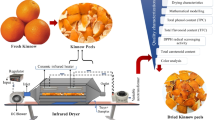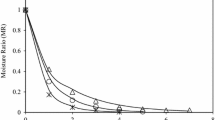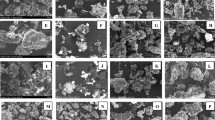Abstract
To investigate the effect of heat on color and surface chemistry of wood flour (WF), unextracted, extracted and delignified samples of commercial WF were heated at 120 °C for 24 h and analyzed by colorimetry, diffuse reflectance visible (DRV), attenuated total reflectance Fourier transform infrared (ATR-FTIR) and Fourier transform Raman (FT-Raman) spectroscopies. Unextracted samples showed a slight increase in CIEL*a*b* color coordinates, a * and b *. Compared with unextracted samples, color changes of the extracted samples varied with composition of the extraction solvents with generally smaller increases in a * and larger decreases in b * values. Delignified samples were marked by even larger increases in both a * and b * values. The color changes could be explained by analysis of the respective DRV, FTIR and FT-Raman spectra of the samples before and after heating. Heating of the extracted WF at 120 °C resulted in a red shift of the absorption at 430 nm and increase in absorption in the violet-blue spectral region of visible light. Delignified samples showed even more pronounced absorption in this spectral region after heating.





Similar content being viewed by others
References
Agarwal UP, Atalla RH (2000) Using Raman spectroscopy to identify chromophores in lignin-lignocellulosics. In: Glasser WG, Northey RA, Schultz TP (eds) Lignin: historical, biological, and materials in perspectives (ASC symposium series 742). American Chemical Society, Washington, pp 250–264
Agarwal UP, Ralph SA (1997) FT-Raman spectroscopy of wood, Identifying contributions of lignin and carbohydrate polymers in the spectrum of black spruce (Picea mariana). Appl Spectrosc 51:1648–1655
Bekhta P, Niemz P (2003) Effect of high temperature on the change in color, dimensional stability and mechanical properties of spruce wood. Holzforschung 57:539–546
Burtin P, Jay-Allemand C, Charpentier JP, Janin G (2000) Modification of hybrid walnut (Juglans nigra 23 × Juglans regia) wood color and phenolic composition under various steaming conditions. Holzforschung 54(1):33–38
Burtscher E, Bobleter O, Schwald W, Concin R, Binder H (1987) Chromatographic analysis of biomass reaction products produced by hydrothermolysis of poplar wood. J Chrom 390:401–412
Ellis S, Paszner L (1994) Activated self bonding of wood and agricultural residues. Holzforschung 48:82–90
Fell D (2002) Consumer visual evaluation of Canadian wood species. Project No. 3282. Vancouver, British Columbia. Forintek Canada Corporation, Canada, p 111
Fengel D, Wegener G (1989) Wood: chemistry, ultrastructure, reactions. Walter de Gruyter, Berlin, pp 26–226
Funaoka M, Kako T, Abe I (1990) Condensation of lignin during heating of wood. Wood Sci Technol 24:277–288
Harris JF, Saeman JF, Zoch LL (1960) Preparation and properties of hydroxymethylfurfural. Forest Prod J 10(2):125–128
Hiltunen E, Alvila L, Pakkanen TT (2006) Characterization of Brauns’ lignin from fresh and vacuum dried birch (Betula pendula) wood. Wood Sci Technol 40:575–584
Kaar WE, Cool LG, Merriman MM, Brink DL (1991) The complete analysis of wood polysaccharides using HPLC. J Wood Chem Technol 11:447–463
King B, Oxley TA, Long KD (1976) Some biological effects of redistribution of soluble nutrients during drying of wood. Material und Organismen 3:263–276
Kocaefe D, Poncsák S, Doré G, Younsi R (2008) Effect of heat treatment on the wettability of white ash and soft maple by water. Holz Roh- Werkst 66(5):355–361
Kreber B, Fernandez M, McDonald AG (1998) Migration of kiln brown stain precursors during the drying of radiata pine sapwood. Holzforschung 52:441–446
LeVan SL (1989) Thermal degradation. In: Schniewind AP (ed) Concise encyclopedia of wood and wood-based materials. Exeter, Pergamon Press, England, pp 271–273
Luostarinen K, Möttönen V (2004a) Effects of log storage and drying on birch (Betula pendula) wood proanthocyanidin concentration and discoloration. J Wood Sci 50:151–156
Luostarinen K, Möttönen V (2004b) Effect of growing site, sampling date, wood location in trunk and drying method on concentration of soluble proanthocyanidins in Betula pendula wood with special reference to wood colour. Scand J Forest Res 19:234–240
McDonald A, Fernandez M, Kreber B (1997) Chemical and UV–VIS spectroscopic study on kiln brown stain formation in Radiata pine. In: 9th international symposium of wood and pulping chemistry, Montreal, vol 70, pp 1–5
McGinnes AE Jr, Rosen HN (1984) Macroscopic and microscopic analyses of color changes of wood pressure steam dried above atmospheric pressure. Wood Fiber Sci 16:48–56
Millet MA (1952) Chemical brown stain in sugar pine. Forest Prod J 2:232–236
Norton AJ (1947) Furan resins. Ind Eng Chem 40(2):236–238
Nunez AJ, Kenny JM, Reboredo MA, Aranguren MI, Marcovich NE (2002) Thermal and dynamic mechanical characterization of polypropylene-wood flour composites. Polym Eng Sci 42:733–742
Nuopponen M, Vuorinen T, Viitaniemi P, Jms S (2003) Effects of heat treatment on the behavior of extractives in softwood studies by FTIR spectroscopic methods. Wood Sci Technol 37:109–115
Papadakis SE, Abdul-Malek S, Kamdem RE, Yam KL (2000) A versatile and inexpensive technique for measuring color of foods. Food Technol 54(12):48–51
Peyer S, Wolcott M (2000) Engineered wood composites for naval waterfront facilities. 2000 yearly report to office of naval research, wood materials and engineering laboratory. Washington State University, Pullman, p 14
Rosu D, Teaca C-A, Bodirlau R, Rosu L (2010) FTIR and color change of the modified wood as a result of artificial light irradiation. J Photochem Photobiol B: Biol 99:144–149
Segnini S, Dejmek P, Öste R (1999) A low cost video technique for colour measurement of potato chips. Food Sci Technol-Lebensmittel-Wissenschaft und Technologie 32(4):216–222
Shafizadeh F (1985) Pyrolytic reactions and products of biomass. In: Overend PP, Milne TA, Mudge LK (eds) Fundamentals of thermochemical biomass conversion. Elsevier, New York, pp 183–217
Sundqvist B (2004) Colour changes and acid formation in wood during heating. Doctoral Thesis, Luleå University of Technology, Luleå
Terziev N (1995) Migration of low-molecular sugars and nitrogen in Pinus sylvestris L. during kiln and air drying. Holzforschung 49:565–574
Theander O, Bjurman J, Boutelje JB (1993) Increase in the content of low molecular carbohydrates at lumber surfaces during drying and correlations with nitrogen content, yellowing and mould growth. Wood Sci Technol 27:381–389
Tjeerdsma B, Boonstra M, Pizzi A, Tekely P, Militz H (1998) Characterisation of thermally modified wood: molecular reasons for wood performance improvement. Holz Roh-Werkst 56:149–153
Tsoumis G (1991) Science and technology of wood: structure, properties, utilization. Van Nostrand Reinhold, New York
Wise LE, Murphy M, D’ Addireco AA (1946) Chlorite holocellulose, its fractionation and bearing on summative wood analysis and on studies on the hemicelluloses. Pap Trade J 122:35–43
Yam KL, Papadakis S (2004) A simple digital imaging method for measuring and analyzing color of food surfaces. J Food Engineer 61:137–142
Yamauchi S, Iijima Y, Doi S (2005) Spectrochemical characterization by FT-Raman spectroscopy of wood heat-treated at low temperatures: Japanese larch and beech. J Wood Sci 51:498–506
Acknowledgments
Authors express their sincere thanks to Sally A. Ralph at USDA Forest Products Laboratory for her help with Raman spectroscopy. Financial support from National Natural Science Foundation of China (series number of the project: 31070490) is gratefully acknowledged. This research was funded in part by China Scholarship Council (CSC).
Author information
Authors and Affiliations
Corresponding author
Rights and permissions
About this article
Cite this article
Chen, Y., Tshabalala, M.A., Gao, J. et al. Color and surface chemistry changes of extracted wood flour after heating at 120 °C. Wood Sci Technol 48, 137–150 (2014). https://doi.org/10.1007/s00226-013-0582-3
Received:
Published:
Issue Date:
DOI: https://doi.org/10.1007/s00226-013-0582-3




